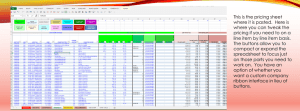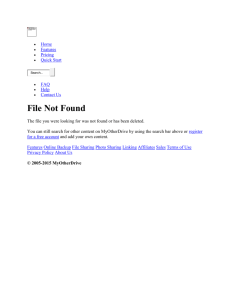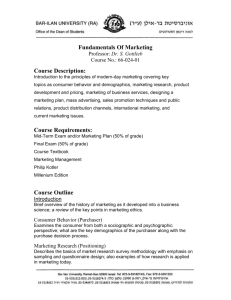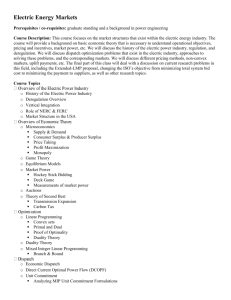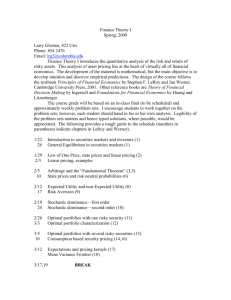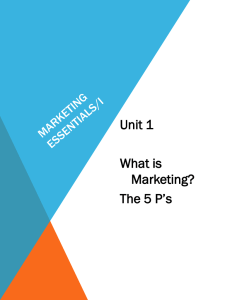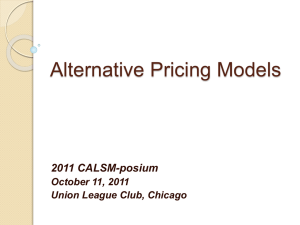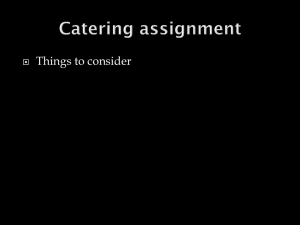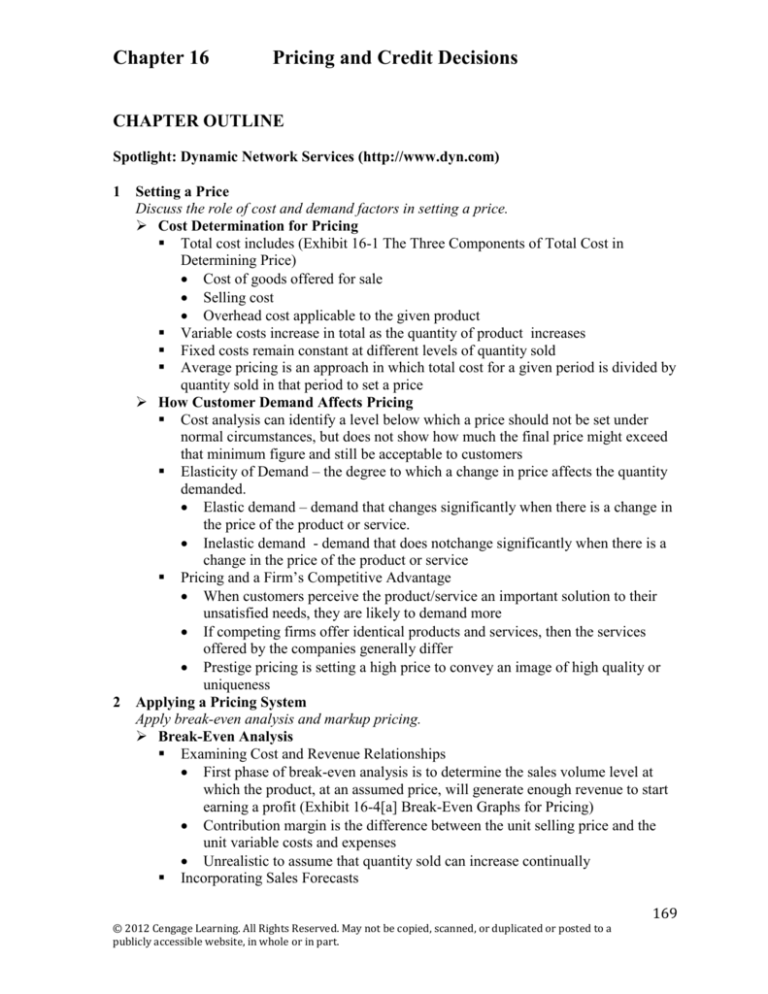
Chapter 16
Pricing and Credit Decisions
CHAPTER OUTLINE
Spotlight: Dynamic Network Services (http://www.dyn.com)
1 Setting a Price
Discuss the role of cost and demand factors in setting a price.
Cost Determination for Pricing
Total cost includes (Exhibit 16-1 The Three Components of Total Cost in
Determining Price)
Cost of goods offered for sale
Selling cost
Overhead cost applicable to the given product
Variable costs increase in total as the quantity of product increases
Fixed costs remain constant at different levels of quantity sold
Average pricing is an approach in which total cost for a given period is divided by
quantity sold in that period to set a price
How Customer Demand Affects Pricing
Cost analysis can identify a level below which a price should not be set under
normal circumstances, but does not show how much the final price might exceed
that minimum figure and still be acceptable to customers
Elasticity of Demand – the degree to which a change in price affects the quantity
demanded.
Elastic demand – demand that changes significantly when there is a change in
the price of the product or service.
Inelastic demand - demand that does notchange significantly when there is a
change in the price of the product or service
Pricing and a Firm’s Competitive Advantage
When customers perceive the product/service an important solution to their
unsatisfied needs, they are likely to demand more
If competing firms offer identical products and services, then the services
offered by the companies generally differ
Prestige pricing is setting a high price to convey an image of high quality or
uniqueness
2 Applying a Pricing System
Apply break-even analysis and markup pricing.
Break-Even Analysis
Examining Cost and Revenue Relationships
First phase of break-even analysis is to determine the sales volume level at
which the product, at an assumed price, will generate enough revenue to start
earning a profit (Exhibit 16-4[a] Break-Even Graphs for Pricing)
Contribution margin is the difference between the unit selling price and the
unit variable costs and expenses
Unrealistic to assume that quantity sold can increase continually
Incorporating Sales Forecasts
© 2012 Cengage Learning. All Rights Reserved. May not be copied, scanned, or duplicated or posted to a
publicly accessible website, in whole or in part.
169
Chapter 16
Pricing and Credit Decisions
Indirect impact of price on the quantity that can be sold complicates pricing
decisions
Markup Pricing
Retailing
Applying a percentage to a product’s cost to obtain its selling price
Manageable pricing system that allows quick pricing of many products
Must cover operating expenses, subsequent price reductions (i.e., such things
as markdowns and employee discounts) and desired profit
3 Selecting a Pricing Strategy
Identify specific pricing strategies.
Penetration Pricing
a technique based on setting lower than normal prices to hasten market acceptance
of a product or service or to increase market share
Strategy can sometimes discourage new competitors from entering the market
niche
Skimming Pricing
Sets prices for products/services at high levels for a limited period before
reducing prices to lower, more competitive levels
Assumes certain customers will pay the higher price due to perception it is a
prestige item
Follow-the-Leader Pricing
Uses a particular competitor as a model in setting a price for a product/service
Price differential options may not work with different size competitors
Variable Pricing
a technique based on setting more than one price for a product or service in order
to offer price concessions to certain customers
Dynamic (personalized) a technique based on charging more than the standard
price when a customer’s profice suggest that the higher price will be accepted.
Price Lining
a technique based on setting a range of several distinct merchandise price levels
Amount of inventory stocked at different quality levels depends on the income
levels and buying desires of a store’s customers
Pricing at What the Market Will Bear - can only be used when the seller has little
or no competition
Some Final Notes on Pricing Strategies
Local, state, and federal laws may affect setting prices (Sherman Antitrust Act
prohibits price fixing)
Sometimes a line of products may have items which compete with each other in
which case the effects of a single product must be considered when setting prices
Adjusting a price to meet changing marketing conditions
Can be costly to the seller and confusing to buyers
Alternative may be a system of discounting design to reflect a variety of needs
Pricing errors can be corrected
4 Offering Credit
Explain the benefits of credit, factors that affect credit extension and types of credit.
Benefits of Credit
170
© 2012 Cengage Learning. All Rights Reserved. May not be copied, scanned, or duplicated or posted to a
publicly accessible website, in whole or in part.
Chapter 16
Pricing and Credit Decisions
Provides small firms with working capital, often allowing marginal businesses to
continue operations
Retail Customers (borrowers)
Ability to satisfy immediate needs and pay for them later
Better records of purchases on credit billing statements
Better service and greater convenience when exchanging purchased items
Establishment of a credit history
Suppliers
Facilitate increased sales volume
Suppliers earn money on unpaid balances
Closer association with customers because of implied trust
Easier selling through telephone- and mail-order systems and over the Internet
Smoother sales peaks and valleys, since purchasing power is always available
Easy access to a tool with which to stay competitive
Factors That Affect Selling on Credit
Credit sales should increase profits, but this is not a risk-free practice
May shift or share credit risk by accepting credit cards
Cost of accepting credit cards includes fraud protection, “chargebacks”
Variety of reasons why small business may decide not to sell on credit including
the type of business, credit policies of competitors, customers’ income levels, and
the availability of working capital
Type of Business
Retailers of durable goods typically grant credit more freely than those that
sell perishables or primarily serve local customers
Big ticket items often must be sold on an installment basis
Credit Policies of Competitors
Age and Income Level of Customers
Availability of Working Capital
Economic conditions
Types of Credit
Consumer credit – financing granted by retailers to individuals who purchase for
personal or family use
Trade credit – financing provided by a supplier of inventory to a client
company
Open Charge Accounts – a line of credit that allows the customer to obtain a
product or service at the time of purchase, with payment due when billed
Installment Accounts – a line of credit that requires a down payment, with the
balance paid over a specified period of time
Revolving Charge Accounts – a line of credit on which the customer may
charge purchases at any time, up to a pre-established limit
Credit Cards
Bank Credit Cards
Entertainment Credit Cards
Retailer Credit Cards
Debit cards
© 2012 Cengage Learning. All Rights Reserved. May not be copied, scanned, or duplicated or posted to a
publicly accessible website, in whole or in part.
171
Chapter 16
Pricing and Credit Decisions
Trade Credit
Terms may be specified (such as 2/10, net 30)
Depends on product sold and the buyer’s and the seller’s circumstances
Affected by tradition within industries
5 Managing the Credit Process
Describe the activities involved in managing credit.
Evaluation of Credit Applicants
The Four Credit Questions
Can the buyer pay as promised?
Will the buyer pay?
If so, when will the buyer pay?
If not, can the buyer be forced to pay?
The Traditional Five C’s of Credit
Character
Capacity
Capital
Conditions
Collateral
Sources of Credit Information
Customer’s previous credit history
Trade credit agencies collect credit information on businesses
Credit bureaus summarize a number of firms’ credit experiences with particular
individuals
Aging of Accounts Receivable
Aging schedule (see Exhibit 16-6 Hypothetical Aging Schedule for Accounts
Receivable)
Billing and Collection Procedures
Timely notification of customers indicating the status of their accounts is most
effective method of keeping credit accounts current
Overdue credit accounts time seller’s working capital
Effective weapon in collecting past-due accounts is reminding the debtors that
their credit standing may be impaired
Bad-debt ratio is the ratio of bad debts to credit sales
Credit Regulation
Variety of federal and state laws that vary from state to state
Federal legislation includes:
The Fair Credit Billing
The Fair Credit Reporting Act
The Equal Credit Opportunity Act
The Fair Debt Collection Practices Act
Pricing and credit decisions have a direct impact on the firm’s financial health
172
© 2012 Cengage Learning. All Rights Reserved. May not be copied, scanned, or duplicated or posted to a
publicly accessible website, in whole or in part.
Chapter 16
Pricing and Credit Decisions
ANSWERS TO END-OF-CHAPTER DISCUSSION QUESTIONS
1. Why does average pricing sometimes result in a pricing mistake?
Average pricing (or average-cost pricing) is the approach that involves dividing
total cost over a previous period by the quantity sold in that period. The resulting
average cost is then used to set the current price. Such a procedure overlooks the
fact that there is a higher average cost at a lower sales level. This higher average
cost is due to a constant fixed cost, which must be spread over fewer units. Small
businesses that use the average pricing method are totally disregarding differences
between fixed and variable costs.
2. Explain the importance of total fixed and variable costs to the pricing decision.
The major problem with average-cost pricing (or average pricing) explains why an
understanding of fixed and variable costs is important. Remember that average-cost
pricing treats all costs as variable. It ignores costs that are fixed and therefore not
the same per unit at different levels of production. Average fixed costs decrease as
production increases, while average variable costs remain the same. Since their
behavior is different, they should not be grouped together in determining price.
3. How does the concept of elasticity of demand relate to prestige pricing? Give an
example.
Elasticity of demand relates to prestige pricing in that prestige pricing is appropriate
when a product or service is characterized by inelastic demand. A product or service
is said to have inelastic demand if an increase in its price raises total revenue.
Prestige pricing is the setting of a higher price to convey an image of high quality
and uniqueness, which are two product or service characteristics that generate
inelastic demand.
4. If a firm has fixed costs of $100,000 and variable costs per unit of $1, what is the
break-even point in units, assuming a selling price of $5 per unit?
Each item sold at $5 will contribute $4 to fixed costs, after $1 is allocated to variable
costs. This means that 25,000 units will have to be sold ($100,000 ÷ $4) to reach
the break-even point. At this level, the total cost of $125,000 ($100,000 fixed +
$25,000 variable) will equal the total sales of $125,000 (25,000 units × $5 selling
price).
5. What is the difference between a penetration pricing strategy and a skimming
pricing strategy? Under what circumstances would each be used?
Penetration pricing involves pricing products or services lower than a normal, longrange market price in order to gain more rapid market acceptance or to increase
market share. This strategy may discourage new competitors from entering the
market if they view the penetration price as a long-term price.
© 2012 Cengage Learning. All Rights Reserved. May not be copied, scanned, or duplicated or posted to a
publicly accessible website, in whole or in part.
173
Chapter 16
Pricing and Credit Decisions
A skimming price strategy sets prices for products or services at high levels for a
limited period before reducing them to a lower level. This strategy is most practical
when there is little threat of short-term competition or when startup costs must be
recovered rapidly.
6. If a small business conducts its break-even analysis properly and finds the breakeven volume at a price of $10 to be 10,000 units, should it price its product at
$10? Why or why not?
Most students will probably say, “Yes, if the business can produce more than
10,000 units.” This is correct, but more can be said. The yes answer assumes that
(1) demand at $10 is equal to or greater than 10,000 units; (2) another, higher price
will not provide greater profits, or this price-and-demand level will reach a profit
goal; and (3) price lining and similar policies are not appropriately implemented in
this case.
7. What are the major benefits of credit to buyers? What are its major benefits to
sellers?
For buyers, credit
Satisfies needs now, while not requiring payment until later
Provides better purchase records
Provides better service and greater convenience in product exchange
Builds a credit history
For sellers, credit
Provide working capital to the firm
Can create a closer association with customers
Can provide a marketing tool
Tends to smooth out sales fluctuation
Provides a tool for competitiveness
8. How does an open charge account differ from a revolving charge account?
With an open charge account, a customer incurs a debt, and payment is due when
the customer is billed. There is usually no finance charge if the customer pays in
full when billed. Also, customers are not generally required to make a down
A revolving charge account is an installment charge account under the terms of
which the seller grants a line of credit that may be used by customers for credit
purchases. A specified percentage of the outstanding balance must be paid monthly.
9. What is meant by the term 2/10, net 30? Does it pay to take discounts when they
are offered?
The credit term 2/10, net 30 means that the seller offers the buyer 2 percent discount
on the agreed-upon price if the account is paid within 10 days of the invoice date.
The full account is due 30 days from the invoice date. It pays to take discounts if
174
© 2012 Cengage Learning. All Rights Reserved. May not be copied, scanned, or duplicated or posted to a
publicly accessible website, in whole or in part.
Chapter 16
Pricing and Credit Decisions
the cash is available and is not earning interest or if the money can be obtained at
an interest charge lower than what can be earned by taking the discount.
10. What is the major purpose of aging accounts receivable? At what point in credit
management should this activity be performed? Why?
Aging of accounts receivable is the process of dividing credit customer charges into
age categories based on the length of time they have been outstanding. The purpose
of aging is to identify the status of each credit charge in order to plan credit
management strategies. There is no particular time when the aging should be done.
In some cases, weekly or monthly aging may be sufficient. At other times, a daily
report may be needed.
COMMENTS ON CHAPTER “YOU MAKE THE CALL” SITUATIONS
Situation 1
1.
What advice would you give Jones regarding the screening of new credit
customers?
Jones should investigate clients, when possible, prior to supplying them with
temporary help. If a new client’s needs are immediate, help could be supplied and
the credit investigation begun concurrently. Banks and trade-credit agencies would
be possible sources of credit information. Jones must be careful not to offend new
clients, but at the same time he must realize that the credit check is simply a good
business practice.
A client application form could be used to obtain relevant information for the credit
evaluation. Jones might also offer a discount for services paid for in cash.
2.
What action should Jones take to encourage current credit customers to pay their
debts? Be specific.
The most important step is to provide timely billing. Most credit customers will pay
their bills on time if they receive proper notification and verification. Jones could
offer a higher discount for credit customers who pay early and/or on time. He could
also devise a formal procedure with timely step-by-step collection actions.
3.
Jones has considered eliminating credit sales. What are the possible
consequences of this decision?
The loss of business is the most obvious consequence of eliminating credit. Many
businesses are set up to make payments on credit, and requiring payment in cash is
an inconvenience to them.
© 2012 Cengage Learning. All Rights Reserved. May not be copied, scanned, or duplicated or posted to a
publicly accessible website, in whole or in part.
175
Chapter 16
Pricing and Credit Decisions
On the other hand, by eliminating credit sales, Jones can eliminate the loss of 2
percent of sales revenue, which could amount to more than the gross revenue lost
as a result of the new policy.
Situation 2
1. What do you think makes selling works of art different from selling other kinds
of products? What makes it the same?
Students’ answers will vary but may include discussion about the subjective
nature of art. Value can be inflated due to perception or hype as this is market is
rather unconventional. This is not a typical product where you add the cost of
materials, labor, overhead and tack on a profit. With art, the material cost is low,
the labor cost is high but the value is mostly perceived. Pricing is completely
subjective based on what the market will bear. What makes it the same is
packaging, branding, and perception. These conventional methods of marketing
translate to any product.
2. Have you bought anything on eBay? If so, do you feel you received good value
for the price you paid? If not, ask someone who has shopped successfully on
eBay for advice on how to shop on that site, and report what you were told.
Student answers will vary on this.
3. How would you price a work of art? What do you think the advantages and
disadvantages of using an auction would be?
Student answers will vary on this.
Situation 3
1. What would the nature of this industry suggest about the elasticity of demand
affecting Bowlin’s pricing?
The nature of this industry is such that service is not standardized. There are large
differences in the services that can be provided. In other words, this service can be
distinguished from other tree removal and pruning businesses. This means that
demand can be very inelastic within a certain range. There is the opportunity to
distinguish the services in such a way that small price increases will cause little
resistance from customers and thereby result in increasing total revenues.
2. What types of costs should Bowlin evaluate when he is determining his breakeven point?
176
© 2012 Cengage Learning. All Rights Reserved. May not be copied, scanned, or duplicated or posted to a
publicly accessible website, in whole or in part.
Chapter 16
Pricing and Credit Decisions
The types of costs Bowlin must evaluate are the same as in any other business—
fixed and variable costs. For Bowlin, fixed costs may include such items as chain
saws, tools, pick-up trucks, and insurance. Variable costs would include gasoline
and labor costs.
3. What pricing strategies could Bowlin adopt to further his long-term success in
this market?
A variable pricing strategy will be required in this type of business because no two
jobs will be exactly the same. Bowlin may also want to consider flexible pricing to
reflect special market conditions such as distant locations and adverse weather
conditions.
4. How can the high quality of Bowlin’s work be used to justify somewhat higher
price quotes?
Bowlin might consider some degree of prestige pricing for certain high-income
customers, which could successfully convey an image of high quality or
uniqueness. This approach could work well if certain customers associate quality
with price.
SUGGESTED SOLUTION TO CASE 16: DYNAMIC NETWORK SERVICES, INC.
1. Explain the importance of fixed and variable costs to Dyn’s pricing decisions.
Since the bulk of Dyn’s costs are fixed, they need to have accurately defined which of
their costs are fixed and which are variable. A miscalculation here could mean they
either overstate or understate their price. Cost and profits would similarly be
affected. Also, should the market change and demand decrease for their product, Dyn
would have to look at reducing their overhead (fixed) costs and would again, need to
rely on accurate data.
2. Basing your answer on the discussion of prestige pricing in Chapter 16 and on the
Dyn Inc. video, how does the concept of elasticity of demand relate to Dyn’s pricing
structure? Or does it?
Because customer demand for a product or service is often sensitive to the price level,
Dyn has to be careful about how it structures its pricing. So far, Dyn has experienced
inelastic demand for as they have increased their pricing, demand has risen.
However, they need to be more careful now. Since they each customer requires
different pricing strategies, Dyn must be careful to appropriate the correct variable
costs to these customers. They also need to appropriate the correct amount of sales
force cost- some of these costs will be fixed (i.e. salary) and some will be variable
(i.e. commission).
© 2012 Cengage Learning. All Rights Reserved. May not be copied, scanned, or duplicated or posted to a
publicly accessible website, in whole or in part.
177
Chapter 16
Pricing and Credit Decisions
Should they utilize the concept of prestige pricing, an approach based on setting a
high price to convey an image of high quality or uniqueness, they need to ensure that
their product is superior over their competitors. With more competitors entering their
market, they have to absolutely deliver on their ability to handle the rate of traffic and
the consistency of their software. To achieve this superb level of quality they may
have to increase their fixed cost. This in turn will affect their pricing and
consequently may affect their pricing elasticity. If customers are price sensitive in this
down economy, Dyn wants to be sure they don’t price themselves out of the market.
3.
Do you think Dyn would benefit from offering credit to its customers?
Offering credit to their customers provides several benefits, such as:
The ability to satisfy immediate needs and pay for them later
Better records of purchases on credit billing statements
Establishment of a credit history
Closer association with customers because of implied trust
Easier selling through telephone- and mail-order systems and over the internet
Smoother sales peaks and valleys, since purchasing power is always available
East access to a tool with which to stay competitive.
Selling on credit though is not a risk-free business. Dyn will incur some extra
administrative cost in establishing credit with credit card companies. Dyn will also
have to pay a service fee to these companies. There’s also the issue of internet fraud.
There’s also the issue of “charegebacks” whenever a buyer disputes a transaction.
It’s probably best if Dyn do a thorough analysis to see if the use of credit would be of
benefit to its existing customers and see if this benefit would be a deciding factor for
new customers.
178
© 2012 Cengage Learning. All Rights Reserved. May not be copied, scanned, or duplicated or posted to a
publicly accessible website, in whole or in part.

